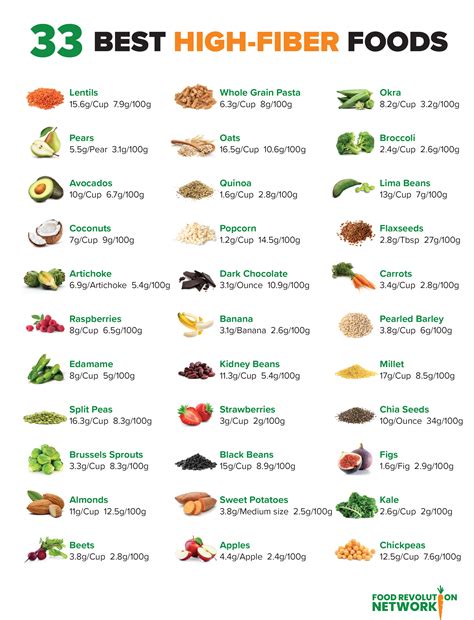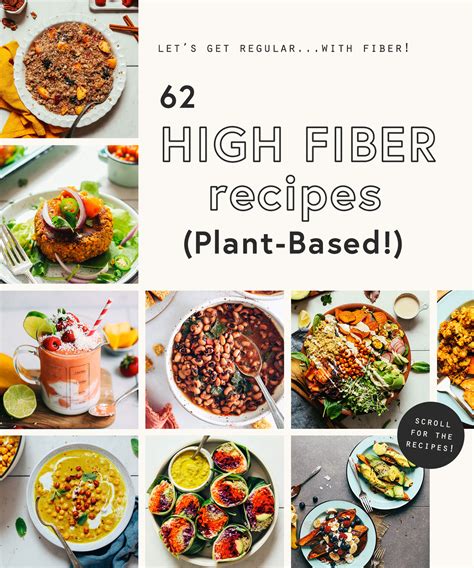Intro
Discover 5 high fiber foods, including fruits, vegetables, and whole grains, that support healthy digestion, boost energy, and promote weight management with soluble and insoluble fiber benefits.
Eating a diet rich in fiber is essential for maintaining good health. Fiber plays a crucial role in digestion, satiety, and blood sugar control. Unfortunately, many people do not consume enough fiber in their daily diets. The recommended daily intake of fiber is 25-30 grams per day, but the average person consumes only about 15 grams. Increasing fiber intake can have numerous health benefits, including promoting regular bowel movements, lowering cholesterol levels, and controlling blood sugar levels. In this article, we will explore the importance of fiber and highlight five high fiber foods that can help you meet your daily needs.
A high fiber diet can also help with weight management. Fiber-rich foods tend to be more filling, which can lead to a reduction in calorie intake. Additionally, fiber can help slow down the digestion of food, keeping you feeling fuller for longer. This can be particularly beneficial for individuals trying to lose weight or maintain weight loss. Furthermore, a high fiber diet has been shown to reduce the risk of chronic diseases, such as heart disease, type 2 diabetes, and certain types of cancer.
Incorporating high fiber foods into your diet can be easy and delicious. There are many foods that are rich in fiber, including fruits, vegetables, whole grains, and legumes. By making a few simple changes to your diet, you can increase your fiber intake and start experiencing the many health benefits that come with it. Whether you're looking to improve your overall health or manage a specific health condition, increasing your fiber intake is a great place to start.
Introduction to High Fiber Foods

Benefits of High Fiber Foods
Some of the key benefits of high fiber foods include: * Promoting regular bowel movements * Lowering cholesterol levels * Controlling blood sugar levels * Aiding in weight management * Reducing the risk of chronic diseases, such as heart disease, type 2 diabetes, and certain types of cancer * Supporting healthy gut bacteriaTop 5 High Fiber Foods

Increasing Fiber Intake
Increasing fiber intake can be easy and delicious. Here are some tips to help you get started: * Start by adding a serving of high fiber food to your meals and snacks each day * Gradually increase your fiber intake over time to allow your digestive system to adjust * Choose a variety of high fiber foods to ensure you are getting a range of nutrients * Consider taking a fiber supplement if you are having trouble getting enough fiber from food sourcesHigh Fiber Food Recipes

Common Mistakes to Avoid
Here are some common mistakes to avoid when increasing fiber intake: * Eating too much fiber too quickly, which can cause digestive discomfort * Not drinking enough water, which can cause constipation * Not choosing a variety of high fiber foods, which can lead to nutrient deficiencies * Relying too heavily on fiber supplements, which can be expensive and may not provide the same health benefits as whole foodsConclusion and Next Steps

We hope this article has provided you with the information and inspiration you need to start making healthy changes to your diet. Whether you're looking to improve your overall health or manage a specific health condition, increasing your fiber intake is a great place to start. So why not get started today and see the difference that high fiber foods can make in your life?
What are the benefits of a high fiber diet?
+A high fiber diet can help promote regular bowel movements, lower cholesterol levels, control blood sugar levels, aid in weight management, and reduce the risk of chronic diseases.
How much fiber should I eat per day?
+The recommended daily intake of fiber is 25-30 grams per day, but the average person consumes only about 15 grams.
What are some high fiber foods that I can add to my diet?
+Some high fiber foods include avocados, legumes, whole wheat spaghetti, Brussels sprouts, and almonds.
How can I increase my fiber intake without experiencing digestive discomfort?
+Start by adding a serving of high fiber food to your meals and snacks each day and gradually increase your fiber intake over time to allow your digestive system to adjust.
Can I take a fiber supplement if I'm having trouble getting enough fiber from food sources?
+Yes, you can consider taking a fiber supplement if you're having trouble getting enough fiber from food sources, but it's always best to talk to a healthcare professional before starting any new supplement regimen.
We encourage you to share your thoughts and experiences with high fiber foods in the comments below. Have you noticed any benefits from increasing your fiber intake? Do you have a favorite high fiber food or recipe? Let us know and help others learn from your experiences. Additionally, if you found this article helpful, please share it with your friends and family on social media to help spread the word about the importance of high fiber foods.
